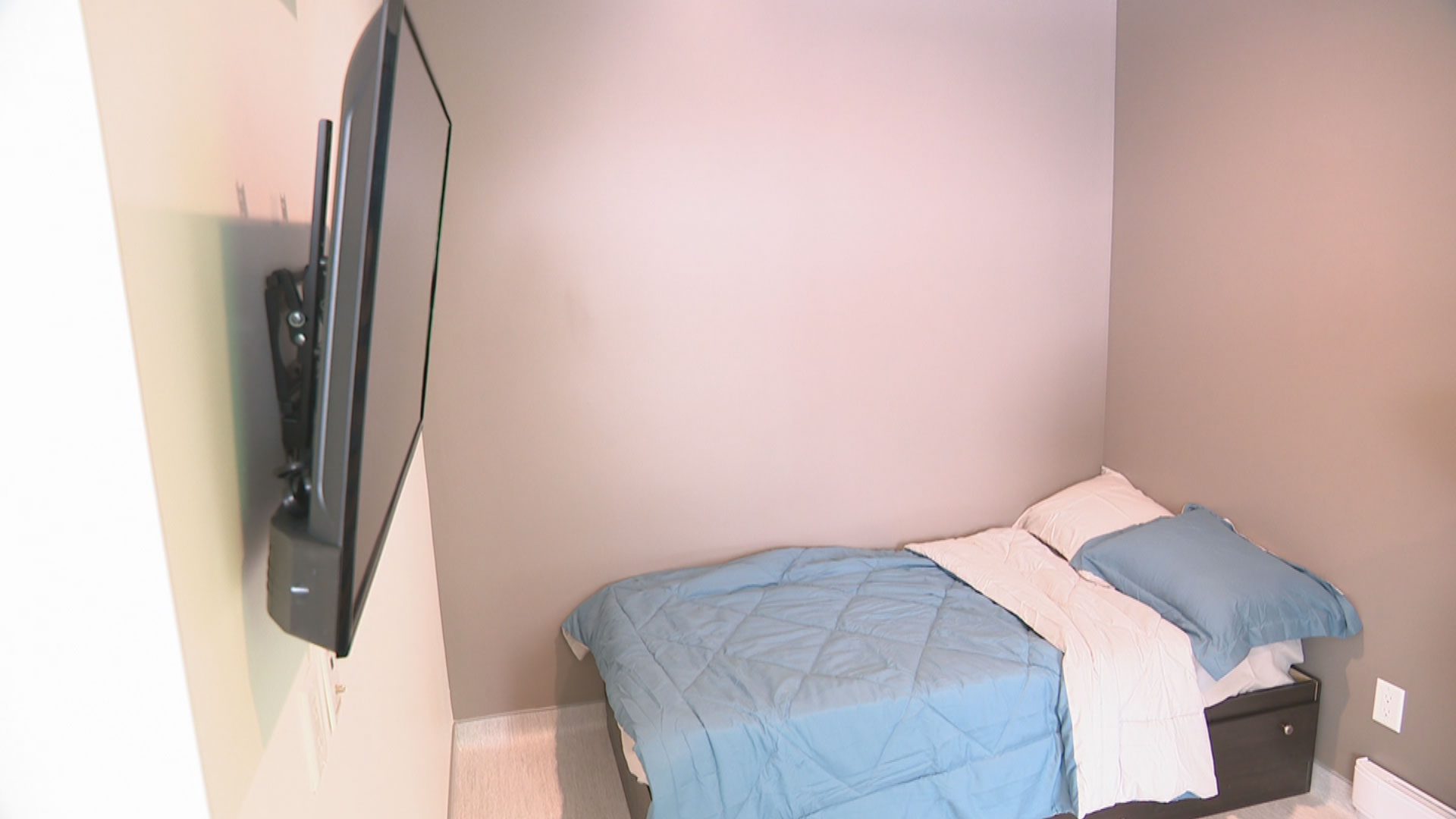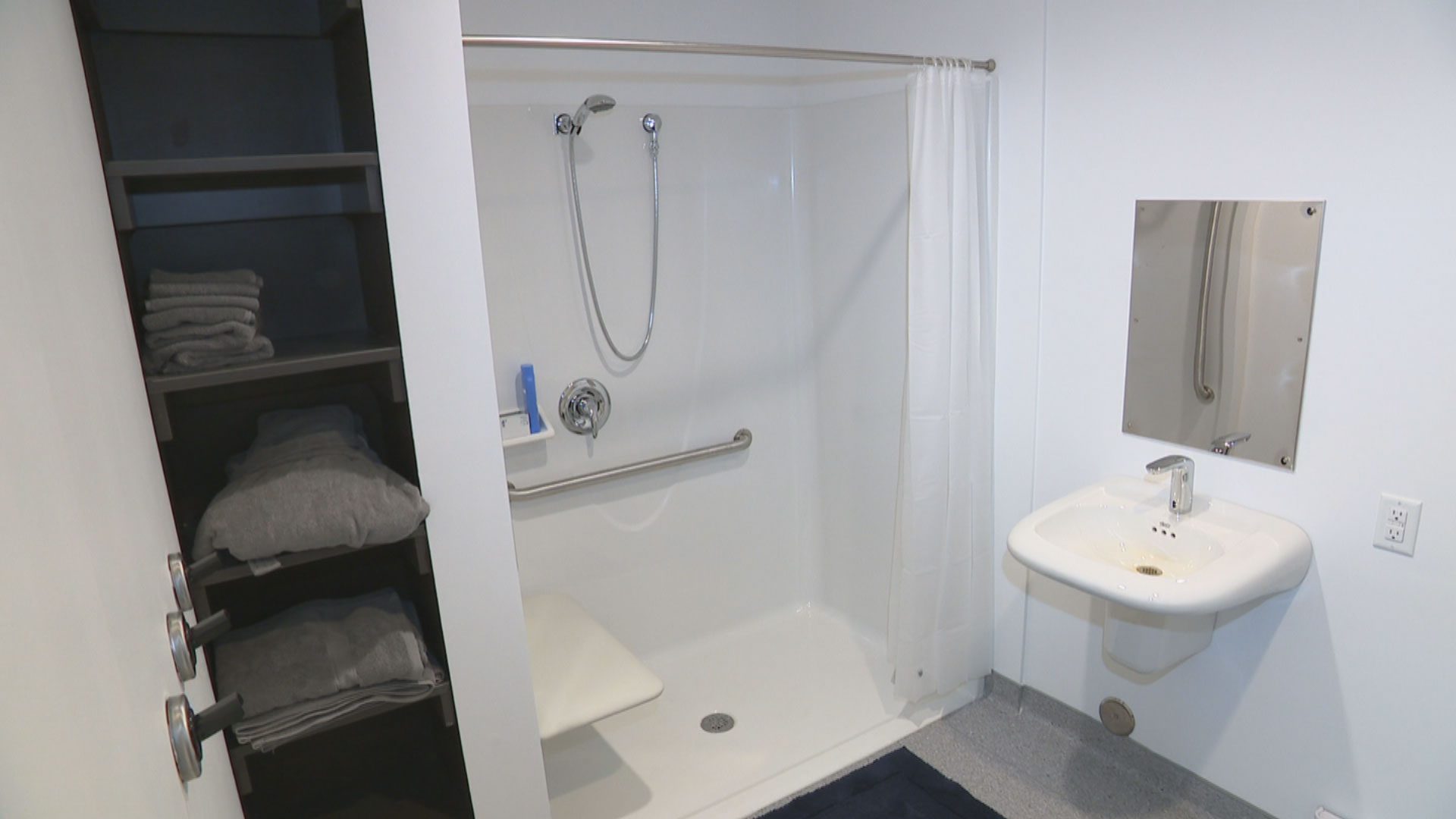A handful of unsheltered residents in Winnipeg finally have a safe place to call their own with the opening of a new transitional housing project in downtown Winnipeg.
Astum Api Niikinaahk’s 22 tiny homes are now being occupied by people who have been resorting to tents, bus shelters, and other inadequate structures to lay their head to sleep at night. Each of the bachelor-style units comes complete with a kitchenette, bathroom and bed. Each unit has direct access to wireless internet and television.
David Redsky, a support mentor for the residents at Astum Api Niikinaahk, says he has high hopes for the residents’ healing journeys now that they have stable housing and supports that are Indigenous-led.
“[G]etting them in touch with their spirituality and their culture,” says Redsky. “That would also probably help their addictions and mental health because I believe that their spirituality and culture is a big thing in them moving ahead and doing better in their life.”
The units are set up as a community. They face each other in a circle around a courtyard, featuring a sacred fire pit and eventually a sweat lodge as well.
Astum Api Niikinaahk means “Come sit at our home” in Michif and was gifted to the project by Two-Spirit and Metis Elder Charlotte Nolin.
Along with cultural activities and ceremonies, the project also offers mental health supports and harm reduction services such as unused pipes and needles, to encourage a successful transition into a more stable environment. An environment some residents say, they haven’t experienced in many years.
About the residents
The coordinator for the project, Melissa Stone, says even with a safe space to sleep at night, there are issues.
“Every night and every day they’re worried about their safety and their items being taken, looking for food, and bathing,” she says. “One of the fellows bathed in the river every day and then when it froze, he was unable to bathe. So, when he moved in here, he had a shower, he had a warm bed and a warm home to sleep in.
“And he didn’t sleep the whole night because, you know, he was on the street for five-plus years, but he felt safe.“
There is no time limit on a person’s stay in their new home. The idea is to help them stabilize at their own pace so they can start healing from any trauma they may have been exposed to before or after they became unsheltered.
“Having the housing units for individuals gives them the chance for some stability,” says Stone, “everyone needs a safe, warm home to lay their heads to rest because without sleep you can’t function.
“Over time, your brain becomes tired, it changes. So, just to have a roof over your head that is safe – and I want to say ‘safe’ is extremely important because the circle said ‘We need to feel safe’.”
The circle, Stone mentions, is an experiential group made up of people who were currently living unsheltered. She says her team scoured the river banks, around vacant buildings, and known encampments to ask for input in the development of the homes.
“We went out and did outreach for many months, built relationships in a good, positive way with folks and asked for their advice and their expertise on, you know, how do we build safe housing that you’ll want to live at.” says Stone.
“Everything here is because of them.”
Many of these same advisors are now living in the homes they helped envision; finally feeling safe thanks to their suggestions of steel doors, high fences, and security cameras.
But while some residents were looking forward to a place to live, others with terminal health issues were looking forward to a safe place to die.
“When we were meeting people, doing outreach and getting advice, we found that there were a lot of people dying on the streets.” says Stone. “Some folks go for [chemotherapy], some folks don’t have the ability to get there, once again those barriers for health. So, we made sure that we saved some rooms for them, that they would be able to die in peace, and to have a home, and to have the support, and to have the love.
“We felt it was very necessary for them to trust us in telling us their stories of not having a safe place to die.”
New kind of program
The project is the first of its kind in Manitoba and though it is innovative, reliable funding has been difficult to come by.
They have received money from the province, United Way, and End Homelessness Winnipeg, but they have not received any from the City of Winnipeg.
“We have a few funders but, with their policies, they can’t provide long term,” says Stone. “So, what we have to do is, every year we have to apply. Right now, we have no funding for food, so that’s another issue.”
APTN News reached out to the City of Winnipeg on why it isn’t funding the program but did not hear back before the story was published.
But there’s no doubt, the city is struggling with people who are houselessness.
End Homelessness Winnipeg creates a street census” report every year about the demographics of unsheltered people in the city. Their report for 2022 contained data on over 1,250 individuals currently without secure housing, and they believe there may be an additional 4,000 people referred to as the “hidden homeless” that are unaccounted for as they tend to couch-surf or have other temporary living situations.
Of the 1,256 people they had data on, the statistics concerning Indigenous people who are unsheltered is striking.
It’s states around 70 per cent of people who are houseless are Indigenous.
The report found that “Indigenous people were more likely to be staying in unsheltered locations. Nearly nine in ten, or 89 per cent, of people who slept outdoors, in abandoned buildings, tents, vehicles, encampments or other public locations were Indigenous.”
This is in contrast to people staying in shelters, where roughly half are non-Indigenous.
Lived experience with child and family services (CFS) is another commonality held amongst those without secure housing.
The report claims that, out of all those who responded to the survey, “50.2 per cent indicated they had spent time in foster care, group homes, or another CFS placement”.
Of that group, 92.3 per cent are Indigenous, and 69.5 per cent are First Nations people who hold status under the Indian Act.
It goes on to further explain that of Indigenous people who are houseless, more than half have spent time in CFS.
Stone says that it is policy-made barriers that are keeping people on the streets.
One of such policies being that of sobriety, something that makes Astum Api Niikinaahk different with its harm reduction approach.
“All they do is focus on the drugs, and the misuse of alcohol. They don’t understand that, as a child nobody grows up saying ‘I want to misuse drugs and alcohol and be homeless’. No child wants that,” says Stone.
“We as a society and as a community, unfortunately, with our policies and our laws, keep people houseless.”
David Redsky says that the need for more housing like this is obvious.
“We sit down and do a referral and there’s someone – like they really want a nice place to stay. They’re explaining their whole situation, their lives and they’re sitting there, you know, and you’re taking down their information. And then you gotta tell them ‘We’ll get back to you’” says Redsky.
“That’s the sad part of it all, and hopefully in the future, we have more places like this.”











